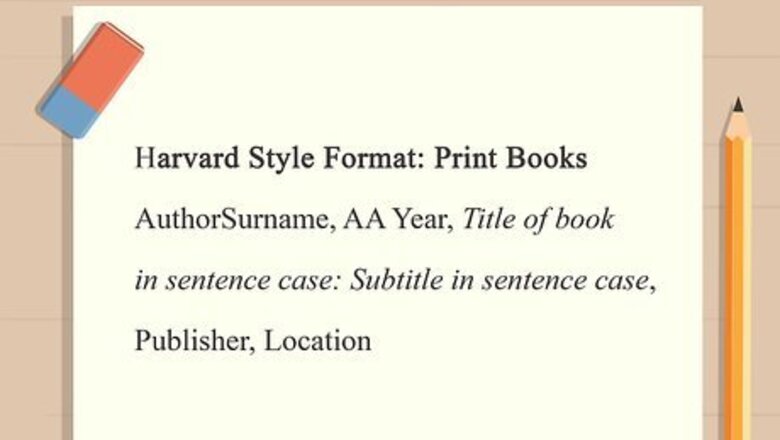
views
X
Research source
Reference List Entry: Print Books

Start with the author's name and year of publication. Type the author's surname first, followed by a comma, then their first and middle initials. Use no spaces or punctuation between the initials. If only the first name is given, provide only the first initial. Type a space after the last initial, then include the year the book was published. Place a comma after the year of publication. Example: Hasler, E 2018, If there are multiple authors, list all of them with the names separated by commas with an ampersand before the final author (such as "Winken, MJ, Blinken, FD & Nod, CT"). If the author has a title, such as Jr, Sr, or III, include the title in your Reference List entry, but not in your in-text citation.
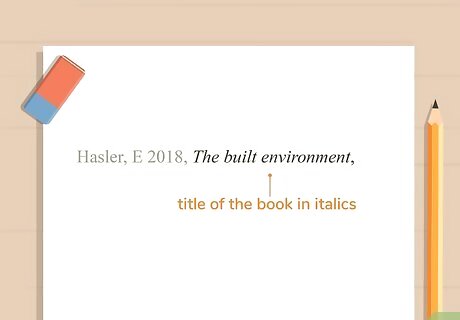
Provide the title of the book in italics. Type the title of the book in sentence case, capitalizing only the first word and any proper nouns in the title. If the book has a subtitle, place a colon at the end of the title and then type the subtitle in sentence case. Place a comma at the end. Example: Hasler, E 2018, The built environment,
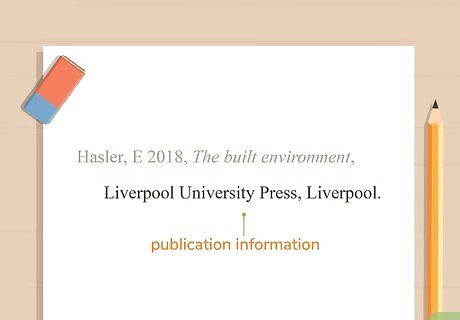
Include publication information for the book. Start with the name of the publisher of the book followed by a comma. Then type the city where the publisher is located followed by a period to close out your Reference List entry. Example: Hasler, E 2018, The built environment, Liverpool University Press, Liverpool. Harvard Reference List Format AuthorSurname, AA Year, Title of book in sentence case: Subtitle in sentence case, Publisher, Location.
Reference List Entry: E-books
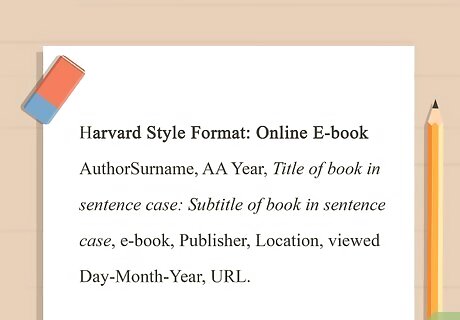
List the author's name and the year of publication. An e-book Reference List entry starts the same way as the entry for a print book. Type the surname of the author followed by a comma. Then type the author's initials with no intervening punctuation. Place a comma after the initials. Example: Burroughs, ER 1918, If there are several authors, include all of their names in your Reference List entry, separated by commas. Before the last author's name, omit the final comma and simply include an ampersand (for example, "Wahlberg, DE, Wood, DW, McIntyre, JM, Knight, JR & Knight, JN").
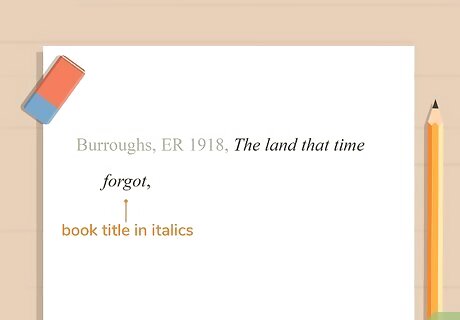
Add the title of the book in italics. When you type the title, only capitalize the first word and any proper nouns. If the book has a subtitle, add a colon to the end of the title. Then type the subtitle, capitalizing the first word and any proper nouns, followed by a comma. Example: Burroughs, ER 1918, The land that time forgot,
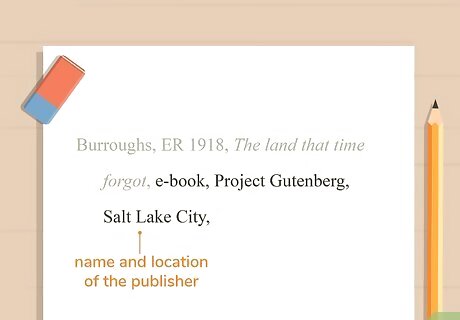
Include the name and location of the publisher. Type the word "e-book" to distinguish the format of the book followed by a comma. Then type the name of the publisher, also followed by a comma. Add the city where the publisher is located, followed by another comma. Example: Burroughs, ER 1918, The land that time forgot, e-book, Project Gutenberg, Salt Lake City,
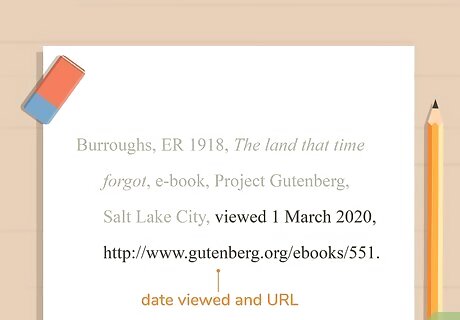
Add the URL if you accessed the e-book online. Type the word "viewed" followed by the date you last viewed the e-book in day-month-year format. Place a comma after the date, then copy the URL for the book. Place a period at the end of the URL. Example: Burroughs, ER 1918, The land that time forgot, e-book, Project Gutenberg, Salt Lake City, viewed 1 March 2020, http://www.gutenberg.org/ebooks/551. Harvard Reference List Format — Online E-book AuthorSurname, AA Year, Title of book in sentence case: Subtitle of book in sentence case, e-book, Publisher, Location, viewed Day-Month-Year, URL.
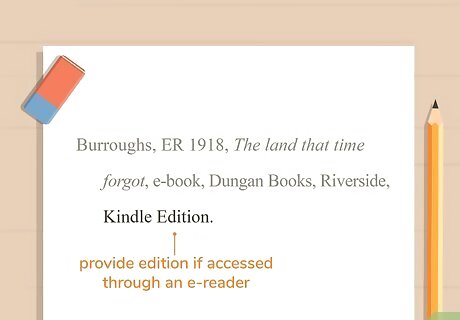
Provide the edition if you accessed the book through an e-reader. After the location of the publisher, type the name of the e-reader you used to access the book. No date of access is necessary for e-reader editions. Add the word "edition" after the name of the e-reader, then close with a period. Example: Burroughs, ER 1918, The land that time forgot, e-book, Dungan Books, Riverside, Kindle Edition. Harvard Reference List Format — E-reader Edition AuthorSurname, AA Year, Title of book in sentence case: Subtitle of book in sentence case, e-book, Publisher, Location, E-reader Edition.
In-Text Citations
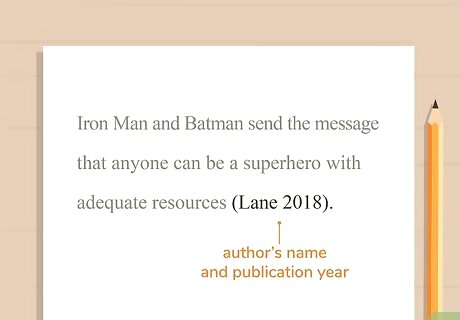
Use the author's name and year of publication for parenthetical citations. All in-text citations include the last name of the author and the year of publication. There is no intervening punctuation between these two elements. For example, you might write: "Iron Man and Batman send the message that anyone can be a superhero with adequate resources (Lane 2018)." If there are 2 or 3 authors, include all of their names in your in-text citation. However, if there are more than 3 authors, use the abbreviation "et al." after the first author's name. For example: (Smith et al. 2020).
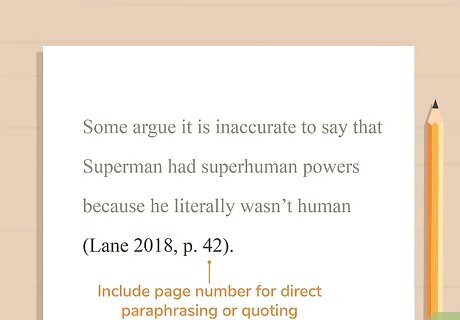
Include a page number if you are paraphrasing or quoting directly. If you include specific information that can be located on a particular page or pages in your source, whether you quote, paraphrase, or summarize that information, Harvard referencing requires a page number in the parenthetical. Add a comma after the year of publication, then the abbreviation "p." (For a single page) or "pp." (for a page range), followed by the appropriate page numbers. For example, you might write: "Some argue it is inaccurate to say that Superman had superhuman powers because he literally wasn't human (Lane 2018, p. 42)."Tip: E-books usually have page numbers. However, if there aren't any page numbers, use the chapter name or number to direct your reader to the material you're referencing.
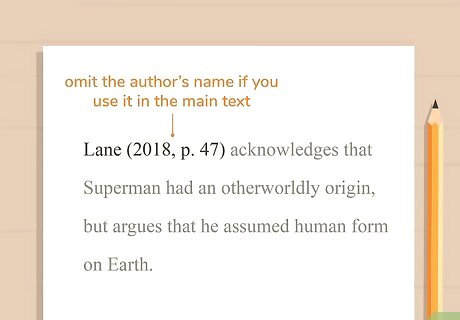
Omit the author's name from the parenthetical if you use it in the main text. If you include the author's name in your text, add the parenthetical immediately after their name. Include the year of publication and the page number or page range. For example, you might write: "Lane (2018, p. 47) acknowledges that Superman had an otherworldly origin, but argues that he assumed human form on Earth."











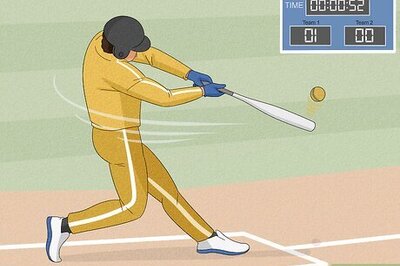



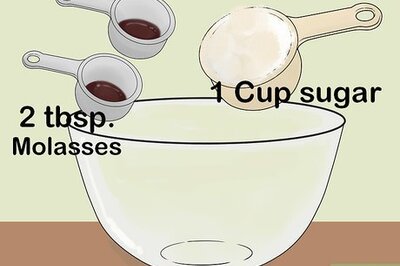



Comments
0 comment